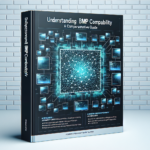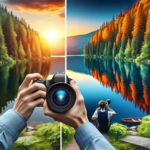Introduction to HDR
High Dynamic Range (HDR) imaging is a revolutionary technique that significantly enhances the quality of photographs and videos. By capturing a wider range of light and color intensity, HDR brings images to life with greater detail and realism. This guide aims to demystify HDR, explaining its principles, benefits, and how to effectively utilize it.
Understanding Dynamic Range
Dynamic range refers to the contrast between the darkest and brightest areas of an image. Traditional imaging techniques often fall short in capturing this full spectrum, leading to loss of detail in shadows and highlights. HDR addresses this by combining multiple exposures to create an image that retains details across all lighting conditions.
How HDR Works
HDR imaging involves capturing several photos of the same scene at different exposure levels and then merging them into a single image. Here are the steps involved:
- Capturing Multiple Exposures: Typically, three to seven images are taken—each with different exposure settings.
- Alignment: Aligning these images is crucial, especially if there is any movement during the shots.
- Merging: The exposures are merged using specialized software to produce a final image with a higher dynamic range.
- Tone Mapping: This process converts the HDR image into a format that can be displayed on standard screens, enhancing local contrasts and details.
Benefits of HDR
HDR photography and videography offer several advantages:
- Enhanced Detail and Realism: By preserving details in both shadows and highlights, HDR creates more lifelike images.
- Improved Color Accuracy: HDR captures a broader spectrum of colors, leading to richer and more accurate tones.
- Better Low-Light Performance: HDR excels in scenarios with challenging lighting, maintaining quality even in dim conditions.
- Creative Flexibility: Photographers and filmmakers can harness HDR to craft unique, compelling compositions.
HDR in Photography
Achieving stunning HDR images in photography requires proper technique and tools:
- Camera Settings: Using manual mode and a tripod ensures stability and consistent framing for multiple exposures.
- Bracketing: Most modern cameras have an auto-bracketing feature that simplifies capturing HDR exposures.
- Post-Processing: Software like Adobe Lightroom and Photomatix Pro are popular for merging and tone mapping HDR images.
Mastering HDR photography expands your creative possibilities, allowing you to capture scenes with unprecedented clarity and depth.
HDR in Videography
HDR is increasingly adopted in videography, providing immersive viewing experiences:
- HDR Video Formats: Popular formats include HDR10, Dolby Vision, and HLG (Hybrid Log-Gamma).
- Editing Tools: Professional video editing software like Adobe Premiere Pro and DaVinci Resolve support HDR content creation.
- Display Technology: To fully appreciate HDR videos, playback on HDR-compatible screens is essential.
HDR videography enhances the emotional and visual impact of your projects, capturing audiences with stunning, realistic footage.
Common Challenges and Solutions
While HDR offers remarkable benefits, it also presents some challenges:
- Ghosting: Moving objects in the scene can create ghosting effects. To mitigate this, use software with advanced de-ghosting algorithms or ensure a short interval between exposures.
- Overprocessing: Excessive tone mapping can lead to unnatural-looking images. A balanced approach in post-processing maintains image authenticity.
- Storage and Processing Power: HDR files can be large and demanding on hardware. Investing in adequate storage and a powerful computer ensures smooth workflow.
Future of HDR
The future of HDR is promising, with continuous advancements in technology and widespread adoption:
- HDR Displays: As HDR-capable TVs and monitors become more affordable, mainstream adoption is expected to rise.
- Enhanced Software Tools: Ongoing improvements in HDR software will streamline workflow and offer innovative features for creators.
- Wider Accessibility: Smartphone cameras increasingly support HDR, making this technique accessible to casual photographers and hobbyists.
HDR is poised to redefine visual media, offering unparalleled realism and creative potential.
Conclusion
High Dynamic Range imaging is a groundbreaking technique that transforms how we capture and perceive visual content. By unlocking the full potential of light and color, HDR delivers images and videos with extraordinary detail, realism, and emotional impact. Whether you are a professional photographer, videographer, or an enthusiast, mastering HDR can significantly elevate your work and creative expression. Embrace HDR and explore the possibilities it offers in creating visually stunning, immersive experiences.
FAQs
- What is the main difference between HDR and traditional imaging?
- HDR imaging captures a wider range of light and color intensity by merging multiple exposures, while traditional imaging captures a single exposure, often losing detail in extreme lighting conditions.
- Can I create HDR images with my smartphone camera?
- Yes, many modern smartphones have built-in HDR modes that automatically capture and process multiple exposures to create HDR images.
- Is HDR suitable for all types of photography?
- HDR is particularly effective for landscapes, architecture, and low-light scenes. However, it’s not always necessary for scenes with balanced lighting and can sometimes produce unnatural results if overused.
- What software is recommended for HDR post-processing?
- Popular software for HDR post-processing includes Adobe Lightroom, Photomatix Pro, and Aurora HDR. These tools offer advanced features for merging exposures and tone mapping.
- Does HDR work in video production as well?
- Yes, HDR is widely used in video production, providing enhanced detail and color accuracy. Popular HDR video formats include HDR10, Dolby Vision, and HLG, and professional editing tools like Adobe Premiere Pro support HDR content creation.










